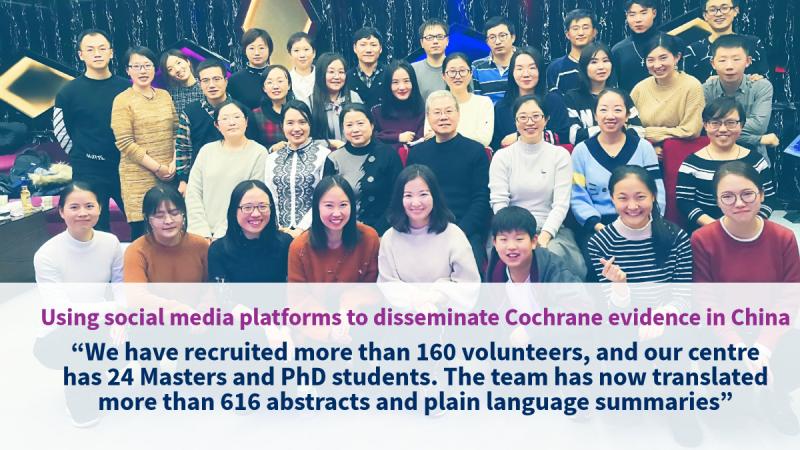

Cochrane’s simplified Chinese multi-lingual team share the secret of their social media success with WeChat in this Cochrane Community blog post.
WeChat is a Chinese multi-purpose messaging, social media and mobile payment app. It was first released in 2011, and by 2018 it was one of the world's largest standalone mobile apps, with over 1 billion monthly active users. It is also known as China's "app for everything" and "super app" because of its wide range of functions and platforms.
We spoke to Cochrane’s simplified Chinese Translation Team: Xun Li (Tina), Chunli Lu (Jenny), Jing Li (previous), and Yuqi Li, who use this tool to both disseminate translations and manage their language translation volunteers.
Can you tell us how you came to use WeChat for knowledge translation activities? What is WeChat for people who don’t know?
WeChat is a social App, like Facebook and Twitter. WeChat is used to talk with up to 500 people in one group. Our WeChat group has 152 people, and all of them can be informed about all messages in the WeChat group. WeChat also has Friend circles, called ‘Moment’ which is similar to a Twitter post. Our manager, Yuqi, edits the post and publishes it in ‘Moment’, which will then go out to the group. All translators can see their contributions published on Cochrane.org and broadcasted in the WeChat friend circle.
In China, almost everyone has a WeChat account, so it is the best way to disseminate Cochrane evidence. Nowadays, there is an increasing number of people from outside China registering with WeChat, so it is becoming even easier to introduce WeChat to them.
You can download WeChat here (English version) or here (Chinese version).
Can you tell us a little about your role and the work of your team in Cochrane?
Our team is based on Centre for Evidence-based Chinese medicine in Beijing University of Chinese Medicine. We have been involved with translation activities since 2007. With CENTRAL, we systematically search Chinese medical journals and Chinese biomedical databases to identify records of controlled trials of TCM therapies.
The citations and abstracts for these records are translated from Chinese into English and added to the Cochrane Complementary Medicine Field database of controlled clinical trials of complementary therapies. It is then published online in the Cochrane Library.
Since 2014, the abstract and plain language summaries of Cochrane Systematic Reviews have been translated from English to Simplified Chinese. These translations are published online on Cochrane.org and the Cochrane Library, and are then disseminated via WeChat by our centre in China. To date, we have contributed over 616 translations of Cochrane systematic reviews.
Tina is the lead and the contact person of the Cochrane Simplified Chinese team. Jenny is responsible for managing all volunteers and translations. Jing Li (previous) and Yuqi Li are responsible for managing WeChat and disseminating Cochrane evidence in Simplified Chinese, translated by our volunteers.
Our team is enthusiastic and active. We have a clear job assignment and we can collaborate closely to promote Cochrane evidence translated and disseminated!
What do you enjoy the most about your Cochrane work?
We can facilitate all volunteers who are interested in Cochrane and evidence-based medicine, and they can all contribute to evidence-based medicine practice, which is pretty meaningful. The work helps Cochrane and evidence-based medicine to be accessible to more people.
What success have you had?
We have recruited more than 160 volunteers, and our centre has 24 Masters and PhD students. The team has now translated more than 616 abstracts and plain language summaries.
Our translation operation mode and WeChat dissemination were presented at the 25th Cochrane Colloquium as both long and short presentations.
We have generated 224 WeChat posts, including podcasts, featured reviews, PLSs and blogshots. As of January 5, 2019, our WeChat Public Subscription has 1,829 followers, and the number is increasing every day. In the last month, we had 2,006 readings, and the number of readers were 1182. But there's still plenty of work to be done.

What impact have you had disseminating Cochrane evidence in this format? To whom?
All WeChat users can view all posts, even if they are not our volunteers. If people don’t have a WeChat account, they can also open the WeChat posts link as a general website on their phone or computer. WeChat posts can be viewed by students, volunteers, doctors, and patients, as posts can be forwarded in other friend circles. We are disseminating posts with different topics to WeChat groups of people with different medical interest.
The current format is like a scientific paper, as most users are scientific researchers. Topics in public health and preventive health may attract more attention.
What have you learnt from using this platform?
WeChat is a social communication platform and a handy tool. It is more familiar for Chinese people, and information can be disseminated more conveniently and widely. By producing posts, we also learn the pattern and principles of information dissemination. Thanks to WeChat ’s statistics function, we also get to know what is more interesting to the readers.
How would you like to develop in this format in 2019?
We will continue the dissemination with WeChat; however, there are many possible improvements:
- As the WeChat posts of Cochrane evidence increase, we are considering setting categories for different posts, such as different types of diseases and medical areas, so that readers can go through post history more easily;
- Expand publicity: We are always encouraging people to follow our WeChat account when there are conferences and academic activities. It would be very helpful if the introduction to our WeChat account could also be presented in some websites, such as somewhere in Cochrane websites;
- We are also considering involving more volunteers for WeChat post production.
What would be your message to other language translation teams who may be interested in using WeChat to publicly disseminate their Cochrane work?
WeChat with its comprehensive functionality meets the needs of social communication. We are willing to share experiences with other translation teams and we can discuss the development mode together.
WeChat is the most popular mobile app in China, with more than one billion monthly active users chatting, playing games, shopping, reading news, paying for meals and publishing their thoughts and pictures. If people in other countries start to use WeChat, it would be practical to use it to disseminate Cochrane work.
Our suggestions include:
- It is necessary to know about the usage condition of WeChat in the country, because the WeChat public dissemination platform is only an additional function of the app.
- It is most effective to promote WeChat public subscription by followers. After we push Cochrane Evidence, all the followers can receive new notifications, and when the followers share WeChat subscription links with their WeChat friend circle, all the follower's friends can see, like and share this content. Therefore, in the early stages, it is suggested to promote in specific groups of people (such as doctors and medical students) to gain followers. Then, get more followers (patients and the public) by sharing translated reviews with them.

